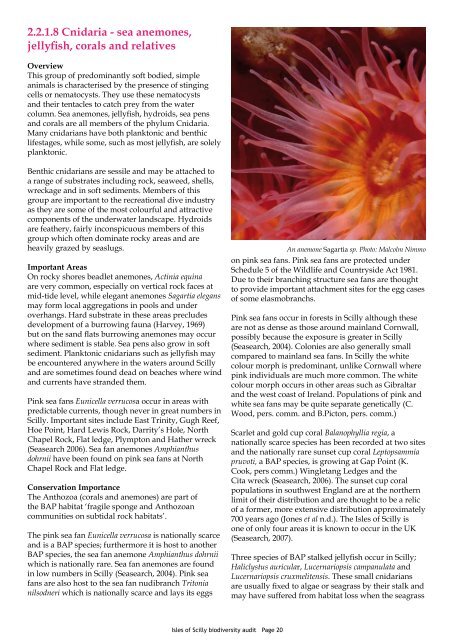The Isles of Scilly Biodiversity Audit 2008 - Cornwall Wildlife Trust
The Isles of Scilly Biodiversity Audit 2008 - Cornwall Wildlife Trust
The Isles of Scilly Biodiversity Audit 2008 - Cornwall Wildlife Trust
Create successful ePaper yourself
Turn your PDF publications into a flip-book with our unique Google optimized e-Paper software.
2.2.1.8 Cnidaria - sea anemones,jellyfish, corals and relativesOverviewThis group <strong>of</strong> predominantly s<strong>of</strong>t bodied, simpleanimals is characterised by the presence <strong>of</strong> stingingcells or nematocysts. <strong>The</strong>y use these nematocystsand their tentacles to catch prey from the watercolumn. Sea anemones, jellyfish, hydroids, sea pensand corals are all members <strong>of</strong> the phylum Cnidaria.Many cnidarians have both planktonic and benthiclifestages, while some, such as most jellyfish, are solelyplanktonic.Benthic cnidarians are sessile and may be attached toa range <strong>of</strong> substrates including rock, seaweed, shells,wreckage and in s<strong>of</strong>t sediments. Members <strong>of</strong> thisgroup are important to the recreational dive industryas they are some <strong>of</strong> the most colourful and attractivecomponents <strong>of</strong> the underwater landscape. Hydroidsare feathery, fairly inconspicuous members <strong>of</strong> thisgroup which <strong>of</strong>ten dominate rocky areas and areheavily grazed by seaslugs.Important AreasOn rocky shores beadlet anemones, Actinia equinaare very common, especially on vertical rock faces atmid-tide level, while elegant anemones Sagartia elegansmay form local aggregations in pools and underoverhangs. Hard substrate in these areas precludesdevelopment <strong>of</strong> a burrowing fauna (Harvey, 1969)but on the sand flats burrowing anemones may occurwhere sediment is stable. Sea pens also grow in s<strong>of</strong>tsediment. Planktonic cnidarians such as jellyfish maybe encountered anywhere in the waters around <strong>Scilly</strong>and are sometimes found dead on beaches where windand currents have stranded them.Pink sea fans Eunicella verrucosa occur in areas withpredictable currents, though never in great numbers in<strong>Scilly</strong>. Important sites include East Trinity, Gugh Reef,Hoe Point, Hard Lewis Rock, Darrity’s Hole, NorthChapel Rock, Flat ledge, Plympton and Hather wreck(Seasearch 2006). Sea fan anemones Amphianthusdohrnii have been found on pink sea fans at NorthChapel Rock and Flat ledge.Conservation Importance<strong>The</strong> Anthozoa (corals and anemones) are part <strong>of</strong>the BAP habitat ‘fragile sponge and Anthozoancommunities on subtidal rock habitats’.<strong>The</strong> pink sea fan Eunicella verrucosa is nationally scarceand is a BAP species; furthermore it is host to anotherBAP species, the sea fan anemone Amphianthus dohrniiwhich is nationally rare. Sea fan anemones are foundin low numbers in <strong>Scilly</strong> (Seasearch, 2004). Pink seafans are also host to the sea fan nudibranch Tritonianilsodneri which is nationally scarce and lays its eggsAn anemone Sagartia sp. Photo: Malcolm Nimmoon pink sea fans. Pink sea fans are protected underSchedule 5 <strong>of</strong> the <strong>Wildlife</strong> and Countryside Act 1981.Due to their branching structure sea fans are thoughtto provide important attachment sites for the egg cases<strong>of</strong> some elasmobranchs.Pink sea fans occur in forests in <strong>Scilly</strong> although theseare not as dense as those around mainland <strong>Cornwall</strong>,possibly because the exposure is greater in <strong>Scilly</strong>(Seasearch, 2004). Colonies are also generally smallcompared to mainland sea fans. In <strong>Scilly</strong> the whitecolour morph is predominant, unlike <strong>Cornwall</strong> wherepink individuals are much more common. <strong>The</strong> whitecolour morph occurs in other areas such as Gibraltarand the west coast <strong>of</strong> Ireland. Populations <strong>of</strong> pink andwhite sea fans may be quite separate genetically (C.Wood, pers. comm. and B.Picton, pers. comm.)Scarlet and gold cup coral Balanophyllia regia, anationally scarce species has been recorded at two sitesand the nationally rare sunset cup coral Leptopsammiapruvoti, a BAP species, is growing at Gap Point (K.Cook, pers comm.) Wingletang Ledges and theCita wreck (Seasearch, 2006). <strong>The</strong> sunset cup coralpopulations in southwest England are at the northernlimit <strong>of</strong> their distribution and are thought to be a relic<strong>of</strong> a former, more extensive distribution approximately700 years ago (Jones et al n.d.). <strong>The</strong> <strong>Isles</strong> <strong>of</strong> <strong>Scilly</strong> isone <strong>of</strong> only four areas it is known to occur in the UK(Seasearch, 2007).Three species <strong>of</strong> BAP stalked jellyfish occur in <strong>Scilly</strong>;Haliclystus auricular, Lucernariopsis campanulata andLucernariopsis cruxmelitensis. <strong>The</strong>se small cnidariansare usually fixed to algae or seagrass by their stalk andmay have suffered from habitat loss when the seagrass<strong>Isles</strong> <strong>of</strong> <strong>Scilly</strong> biodiversity audit Page 20
















